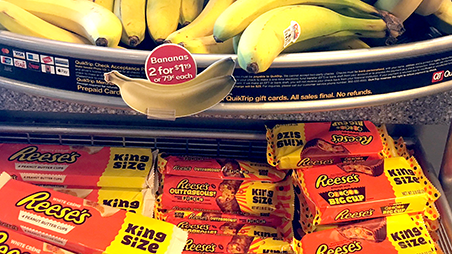There are lists all over the internet of industries that millennial age consumers have killed – diamonds, napkins, beer, home ownership, print news (YIKES!), Applebee’s – but there’s one that those of us who follow retail produce should be watching: bananas.
Saying millennials might “kill” bananas is an extreme, and meant to be provoking. But, let’s think on this for a minute.
I was recently asked to speak to a working group focused on sustainable production for the World Banana Forum, a group comprised of stakeholders in the global banana supply chain focused on banana best practices for sustainable production and trade.
My topic was the retail price perception of bananas in North America, based on a conversation I recently had with Jennie Coleman, president and CEO of Equifruit, a Montreal-based Fairtrade banana supplier.
Bananas are cheap. They’re too cheap. We all know they’re too cheap to be sustainable in the long term. Retailers in North America have kept their banana prices low for decades, sometimes into loss-leader territory, to maintain a price perception that I think is becoming outdated.
Why?
It used to be that “everyone knows the price of bananas,” but I really don’t think that’s true for Millennials, and even Generation X, and CERTAINLY not Generation Z consumers.
If you’re holding your banana prices low to market to these groups, you’re missing the target. That’s marketing to a millennial’s grandmother.
The gap in likelihood of purchase for millennial and generation Z consumer purchase of bananas continues to widen. These consumers choose items like berries, club and branded apples and mangoes.
They don’t care how much bananas cost, because they don’t buy them as often, for a lot of reasons. It could be that they don’t fit into whatever low-carb diet is the trendiest at the moment. I hear keto is all the rage. It could be that they don’t want to buy them because they’re afraid they’ll go bad before they eat them.
Seven or eight bananas is a big ask for some of these consumers, who can’t seem to plan farther ahead than breakfast.
Couple that with the troubling sustainability story in much of the banana world, and it could be a recipe for a sharp decline in demand. There are exceptions, of course, with organizations that are working to change these conditions, but it’s an uphill battle from almost every angle: marketing, supply chain and retail.
I showed a series of pictures to the WBF group, painting a bleak picture of retail, from 39 cents a pound up to 99 cents a pound.
Where were bananas NOT cheap, though?
Convenience stores.
Airports.
Starbucks.
Bananas are a thriving addition to these locations because they’re a natural trade up, nutritionally, from candy bars or potato chips.
It’s an easy swap for a captive audience. Paying 50 cents or a dollar for a banana is no big deal when your alternative is 500 calories of chocolate for the same price.
I’ve seen a few retailers take a stand with banana prices, but they’re few and far between. The good news is, most of the retailers I know of who lowered prices to match Amazon’s Whole Foods price ploys only lasted a few months, at best.
That steep loss of margin puts a lot of pressure on other produce categories.
Something has to give, or bananas will be the latest entry on this:



